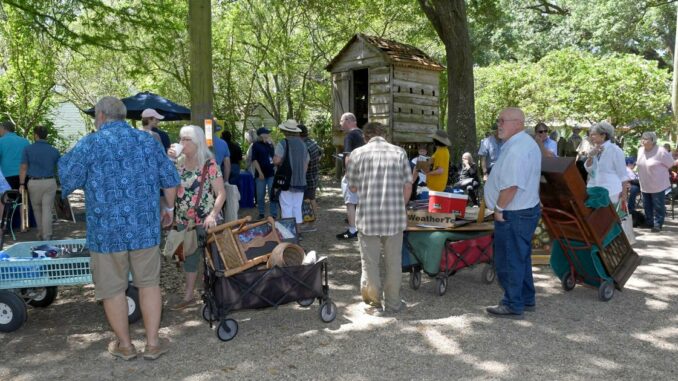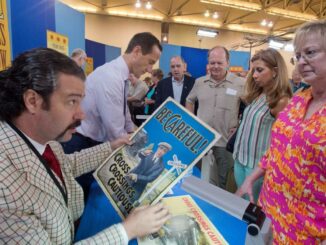
Through the years, my husband and I have watched almost every episode of “Antiques Roadshow.” We were lucky enough to get tickets back in 2013 when the show was last in Baton Rouge. Then, we were even luckier to get tickets again to attend the May 2 taping of the show at the LSU Rural Life Museum, along with 5,400 others.
My husband and I each took our allowed two items. He insisted our treasures be tiny and lightweight and would not agree to schlep the 6-foot-by-5-foot painting I wanted to take.
Folk arts appraiser Ken Farmer explains the value of this Choctaw basket.
Therefore, we settled on a small bronze Chinese container, a porcelain Chinese vase, a Choctaw basket and a damask tablecloth that I’ve had for 28 years (on which Muhammad Ali had used a ballpoint pen to draw an unusual beach scene — more about that later.)
We arrived at the museum around 10 a.m. The day could not have been more perfect. Under the canopy of gigantic trees, 65 appraisers in 23 categories sat behind tables as individuals lined up to show their treasures, which did not all follow my husband’s rule of being able to be toted with one hand.
In the hubbub of so many people going in so many directions with so many things, I watched the amazing variety of items and considered that each piece had a story, just like each person has a story. A quick chat with the show’s executive producer, Marsha Bemko, confirmed that I wasn’t the only one thinking about the ways the show focuses on the humanity we share.
“Doing this show confirms for me that we want the same things. We’re all the same. It levels the playing field,” Bemko said. “I want world peace. Can ‘Roadshow’ do it?”

Jan Risher, left, features editor at The Advocate, and Marsha Bemko, ‘Antiques Roadshow’ executive producer
Bemko explained that she and her team spent the early morning reviewing 1,856 early bird items. Of the 1,856, Bemko picked 11 appraisals to be filmed — which doesn’t mean that all 11 will make the show. She said once the day was done, they will make three hours of television from the footage shot in Baton Rouge — not only for “Antiques Roadshow,” but also a show called “Junk in the Trunk.”
By noon, notable appraiser Nicholas Lowry, who specializes in prints and posters, said he had appraised two Huey Long campaign posters he had never seen before. He estimated the posters to be valued between $3,000 and $4,000 each.
Lowry’s primary observation about his Baton Rouge experience was this: “Everybody here is damn nice.”
He and the other 64 appraisers are all volunteers who pay their own expenses to be a part of their show.

‘Antiques Roadshow’ appraiser Nicholas Lowry, who specializes in prints and posters
Once my husband and I started our appraisal experiences, our first stop was called the triage area. A person looked at what we brought and assigned us to the appropriate areas. In our case, we went to the Asian arts table, the folk art table and the sports memorabilia table.
At the Asian arts stop, appraiser Lark Mason took a look at the small bronze container I bought from an antiques store in Beijing long ago. I explained that I previously brought it to the 2013 “Antiques Roadshow.” He asked if he had appraised it — and I wasn’t sure. I knew a young fellow had initially looked at it. He called over another, older fellow. Mason pointed to his son and said that maybe it was him — I believe it was.

Bronze Chinese container that may or may not be very, very old.
In 2013, they told me the small piece was made in or around the 1200s and was used to hold face powder, usually for Chinese nobility. This time, things took a different turn. Mason told me it was actually used to hold wax for seals and that he thought it was a fake! He then picked up the Chinese vase I brought and said it was Japanese. I explained that I literally bought it at the factory where it was made in China, and he said it was a Chinese vase in a Japanese style.
At that point in the day, I was not sure what to think. My pin-in-the-balloon experience had me questioning the expert and also wondering if I was doing what people do when they hold on to a belief or story because they want to and without evidence. (I don’t want to be one of those people and am now wondering how to test the age of metal to determine the piece’s actual age.)
Moving on to folk arts. Expert appraiser Ken Farmer took one look at my Choctaw Indian basket and said it was a beauty. He explained that it was made of dried river cane and that he wasn’t sure why Cherokee baskets were worth so much more than Choctaw ones — while the two were very similar. He told us about a website called liveauctioneers.com that he often uses to help determine the value of some pieces.

Leigh Keno, a popular folk art appraiser, second from right, holds a Circus banner from the 1940s during the filming of ‘Antiques Roadshow’ in Baton Rouge on Tuesday.
“All you need is a screen name and a password and you can have my job,” he said with a laugh. “Well, not exactly.”
He estimated the basket to go at auction for about $400.
From there, we walked down to the sports memorabilia table and met Leila Dunbar. When I showed her the damask tablecloth with the Muhammad Ali drawing and two name tags (one mine and one his) that he had autographed, she told me that she had actually handled his estate.
She knew how much the great boxer and civil rights leader liked to draw. She said that he often drew a boxing ring surrounded by a crowd with him in the middle. For some reason, on the day I met him back in 1995 at the Mansion on Turtle Creek in Dallas, he had opted to draw a most unusual beach scene complete with a plane, rocket ship and a being of some sort, perhaps an alien.

Muhammad Ali’s ball-point-pen drawing of a beach scene on a tablecloth.
Dunbar gave me all sorts of interesting information about my unusual Muhammad Ali pieces. Let’s just say that we’ll wait and see if it ends up on the cutting room floor or makes the show, but getting picked to be filmed was exciting. Whether it will make the show in 2024 remains to be seen. Even so, being a part of the process of them setting up the filming and seeing how that part of the show works was as interesting as what I learned about our treasures.
All in all, our morning at “Antiques Roadshow” ran the gamut of emotions and left me with admiration for the process and questions, too.
Now, if only we knew more about that 6-foot-by-5-foot piece of art my husband wouldn’t agree to take.
The day and the LSU Rural Life Museum were so beautiful that once the show airs, I expect hoards of people to head to Baton Rouge from all over to visit the museum specifically — so, if you haven’t been, get in now and beat the crowds. It’s an amazing place.


Leave a Reply